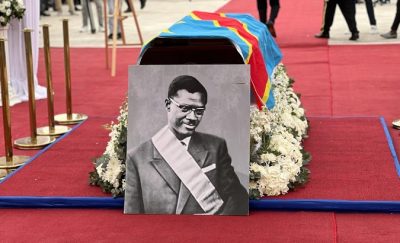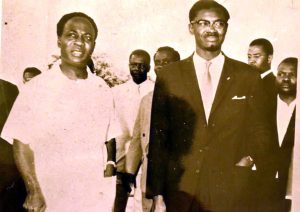The Legacy of Colonialism on the African Continent: The Assassination of Patrice Lumumba
Belgium Returns the Remains of Congolese Leader Patrice Lumumba. Overthrown and brutally executed, the Central African state’s first elected leader is still honored more than 60 years later

All Global Research articles can be read in 51 languages by activating the “Translate Website” drop down menu on the top banner of our home page (Desktop version).
To receive Global Research’s Daily Newsletter (selected articles), click here.
Follow us on Instagram and Twitter and subscribe to our Telegram Channel. Feel free to repost and share widely Global Research articles.
***
Since January 17, 1961, the circumstances surrounding the kidnapping and assassination of Congolese Prime Minister Patrice Lumumba has remained a symbol of the legacy of colonialism on the African continent.
Lumumba rose to prominence during 1958-1960 due to his involvement in independence politics when the people of the former Belgian colony of Congo rose up in rebellion to demand national liberation.
His only known bodily remains, a tooth, had been held in Belgium as a souvenir from those who carried out his torture and execution. As an act aimed at making amends for the legacy of colonialism in the Belgian Congo, the tooth was returned to the DRC and given a proper burial by the current government of President Felix Tshisekedi. (See this)
The details of the murder of Lumumba and two of his cabinet members, Maurice Mpolo, Minister of Youth and Sports along with Joseph Okito, the Second Vice President of the Senate, were gruesome. After being taken to Thysville, located approximately 100 miles from Leopoldville, a disagreement erupted among the Congolese troops who were divided over whether to support the MNC-Lumumba.
Lumumba and his comrades were killed by a firing squad of Belgian troops. Later their bodies were destroyed with acid in efforts to conceal the evidence.
U.S. and Belgian-backed puppet leader, Col. Mobuto Sese Seko, who had declared himself leader of the country at the aegis of Washington in September 1960, arrived at the military camp in Thysville just days prior to the assassinations. Mobuto and other Belgian officers ordered Lumumba, Okito and Mpolo taken to Elizabethville, (now known as Lubumbashi), the center of the mining areas in Katanga province. This area had been deliberately broken off by a secessionist putsch during the early days of independence in efforts to undermine the MNC-Lumumba administration in Leopoldville.
After taking office on June 30, 1960, in the capital of Leopoldville (now Kinshasha), Lumumba and his Congolese National Movement (MNC) political party set out to institute a people’s government in the newly independent state. However, the imperatives of the Belgian colonialists and their western allies had no interest in allowing MNC-Lumumba to implement a program based upon anti-imperialism and Pan-Africanism.
This intransigence on the part of Brussels and Washington was clearly based upon the strategic mineral wealth which exists in the country now known as the Democratic Republic of Congo (DRC). The imperialist powers could not afford to allow these vast reservoirs of natural resources such as cobalt, diamonds, gold, copper, cassiterite (tin ore) and coltan, as well as timber, coffee and oil to be utilized by the African people to build an independent existence in cooperation with other states.
After Lumumba and his comrades were removed by the Belgian military officials and the western-backed collaborators in the DRC, he was tortured and killed in Elizabethville, Katanga. Moise Tshombe, who had been selected, groomed and installed by the Belgium government and the United States as head of Katanga, was projected by the imperialist-oriented media outlets as one of the responsible leaders in the country. These developments created chaos in Leopoldville (now Kinshasha), isolating the capital in the west of the country from the mineral rich areas of the south and east of the country.
The Role of the U.S. in the Coup Leading to the Assassination of Lumumba
To establish a pretext for the elimination of Lumumba, the administration of President Dwight Eisenhower labelled him as “pro-communist” and a threat to western interests. Lumumba sought to build good relations with the U.S. as well as the Soviet Union in 1960. The Congolese prime minister even visited the U.S. during the summer of 1960 in order to meet with the president. Nonetheless, Eisenhower refused to talk with him and continued the hostile policy towards the new government in Leopoldville.
High-level Central Intelligence Agency (CIA) officers working in the U.S. embassy in Leopoldville, were ordered to overthrow the MNC-Lumumba administration and to bring about his liquidation. A 2001 report into the assassination by a Belgian Commission provided details of the joint U.S.-Belgian plan to kill Lumumba.
Initially there was a CIA plot to poison Lumumba right at the headquarters of the independence government. President Dwight D. Eisenhower, according to documents released decades later, had authorized the assassination of Lumumba in 1960.
Nonetheless, the plot to poison him was unsuccessful. CIA-employed chemist Sidney Gottlieb concocted poisonous agents to be used for the assassination. During September 1960, Gottlieb transported the poison to Leopoldville while Larry Devlin, a CIA operative with official diplomatic cover, came up with a scheme to infect Lumumba’s toothbrush or his food. Despite these plans, Devlin’s operatives were unable to carry out the assassination at this time.
A voluminous book by Madeleine G. Kalb, entitled Congo Cables, documents communications by Devlin at the time which encouraged the assassination of Lumumba. Later the CIA station chief helped to conduct the search for Lumumba after he left Leopoldville to join his supporters in establishing an alternative government in the east of the vast country. Devlin was a key figure in arranging Lumumba’s transfer to Katanga while the CIA base chief in Elizabethville was in direct touch with the assassins the same day that Lumumba was killed.
John Stockwell, a CIA officer in the Congo and later a station chief, wrote in 1978 in his book entitled In Search of Enemies, that a CIA agent had the bodies in the trunk of his car in order to dispose of them. Stockwell believed that Devlin knew more than anyone else about the assassination of Lumumba, Okito and Mpolo.
Kalb also asserts that it was during a National Security Council meeting in Washington that Eisenhower gave the order to eliminate Lumumba. The assassination was carried out just three days prior to the inauguration of President John F. Kennedy on January 20, 1961. Kennedy, after taking office, covered up the U.S. role in the coup against the MNC-Lumumba government and the assassination of these three African leaders.
After the assassination of Lumumba, the U.S. administrations beginning with Kennedy right up until Bill Clinton, supported the regime of Mobuto. Untold national wealth was expropriated from the DRC by banks and mining conglomerates, a process which continues until today. The Mobuto regime was overthrown by the Allied Democratic Forces for Liberation (ADFL), led by Laurent Kabila in 1997.
Image on the right: Patrice Lumumba and Kwame Nkrumah
Other imperialist states have been implicated in the plot to overthrow and liquidate Lumumba including Britain and Canada. The United Nations military forces, which were invited into the country by Lumumba in his attempt to end the Belgian occupation, refused to secure the MNC government and instead objectively sided with the forces of counter-revolution. (See this and this)
After the assassination of Lumumba and the destabilization of the Congolese Revolution, the imperialist turned their attention to removing the first independence government in the West African state of Ghana (formerly a British colony known as the Gold Coast) led by Dr. Kwame Nkrumah, the prime minister and later president of the country. Although Nkrumah wrote in his post-coup book, Dark Days in Ghana (1968), that the CIA utilizing the U.S. embassy coordinated his removal from office, Stockwell in his 1978 work, In Search of Enemies, confirmed that the CIA station chief engineered the removal of Nkrumah’s Convention People’s Party (CPP) administration on February 24, 1966.
The coup in Ghana was conducted in a manner that made it appear as if it was a military and police operation. However, Nkrumah’s removal could not have taken place without the leading role of the CIA and the State Department. Documents related to this blatant interference in the internal affairs of Ghana have been subsequently declassified.
These historical events illustrate the vested interests of imperialism in preventing the genuine independence and unity of the African continent. Even in the current period, Washington and Wall Street are still seeking to maintain their hegemony over Africa and other geo-political regions of the world.
*
Note to readers: Please click the share buttons above or below. Follow us on Instagram and Twitter and subscribe to our Telegram Channel. Feel free to repost and share widely Global Research articles.
Abayomi Azikiwe is the editor of the Pan-African News Wire. He is a regular contributor to Global Research.
All images in this article are from the author


